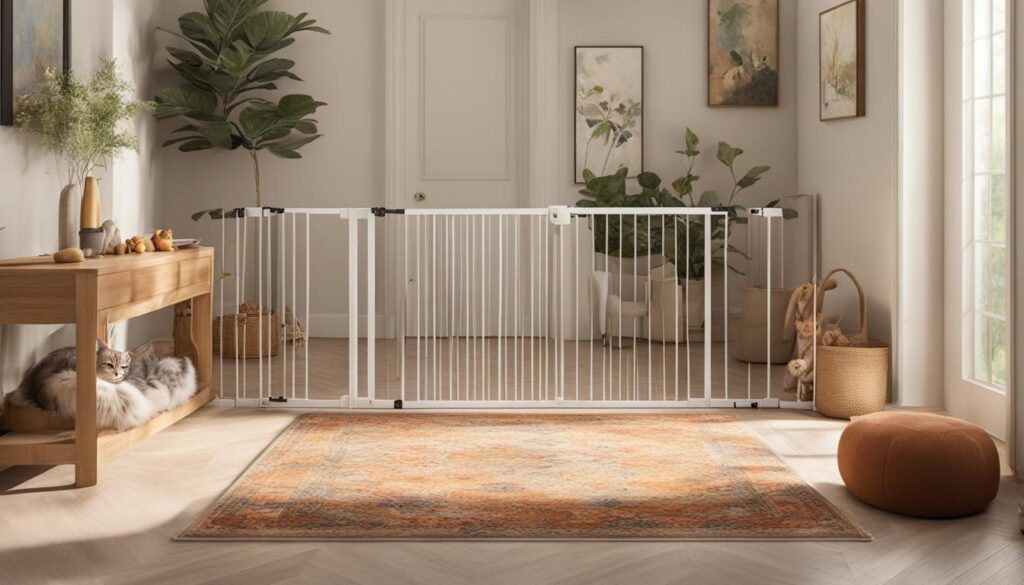Introducing a Cat to a Dog: Step-by-Step Guide
Welcome to Pawges.com, your go-to resource for all things pet-related. Today, we are going to delve into the process of introducing a cat to a dog. Whether you’re bringing a new feline friend into your canine household or simply trying to create a harmonious relationship between your existing pets, we’ve got you covered. With our step-by-step guide, you’ll learn how to navigate the introduction process with ease, ensuring a smooth transition and a bond that lasts a lifetime. Let’s get started!
Key Takeaways:
- Understand the unique personalities and behaviors of your cat and dog before introducing them.
- Create a safe and controlled environment by establishing separate zones and using scent swapping techniques.
- Follow a step-by-step approach, starting with the initial confinement period and gradually progressing to supervised interactions.
- Monitor body language and behavioral cues to ensure a positive interaction and prevent potential conflicts.
- Maintain peace between your cat and dog by implementing positive reinforcement strategies and scheduling supervised interactions.
Understanding Your Pets’ Personalities
Before introducing a cat to a dog, it is crucial to understand the unique personalities and behaviors of both pets. Cats and dogs have different temperaments, instincts, and communication styles. Some cats may be more social and adaptable to new environments, while others may be more independent and territorial. Likewise, certain dog breeds may have a higher prey drive or energy level that can affect their interactions with cats. By understanding your pets’ personalities, you can better prepare for the introduction process and anticipate any potential challenges.
Creating a Safe and Controlled Introduction Environment
Introducing a cat to a dog can be an exciting but delicate process. To ensure a successful introduction and minimize potential conflicts, it’s essential to create a safe and controlled environment for both pets. By following a few key steps, you can help foster a positive relationship between your cat and dog.
Establishing Separate Zones
Before bringing your new cat home, it’s crucial to establish separate zones for each pet. This allows them to have their own space where they feel secure and can gradually adjust to the presence of the other. It’s recommended to provide separate rooms or areas, complete with their own food, water, litter box, and comfortable resting spaces. This separation will help prevent territorial conflicts and allow both pets to become familiar with each other’s scents without direct contact.
Scent Swapping Techniques
A crucial step in the introduction process is familiarizing your cat and dog with each other’s scents. Scent swapping can help reduce anxiety and facilitate a more positive initial meeting. You can start by swapping bedding between the pets, allowing them to sniff and explore each other’s scent. Another effective technique is rubbing a towel or cloth on one pet and placing it near the other, allowing them to become accustomed to the scent gradually. By incorporating scent swapping into the introduction process, you can help create a sense of familiarity and comfort for both pets.
Gradual Visual Exposure
Gradual visual exposure is another important aspect of introducing a cat to a dog. By using barriers or partially obstructed views, you can allow the pets to see and observe each other without direct contact. This technique helps reduce fear and anxiety, especially if one of the pets is initially skittish or apprehensive. You can use baby gates or pet gates to create separate spaces while still allowing visibility. As the pets become more comfortable, you can gradually increase the visual exposure until they are ready for face-to-face interaction.

No forces should be used to rush the introduction process. Each pet will have its own unique timeline for adjustment, so it’s important to be patient and observe their individual behaviors and reactions. By creating a safe and controlled introduction environment, establishing separate zones, implementing scent swapping techniques, and allowing gradual visual exposure, you can set the foundation for a successful integration of your cat and dog.
How to Introduce a Cat to a Dog Step by Step
In this section, we will provide a detailed step-by-step guide on how to introduce a cat to a dog. By following these steps in a structured manner, you can ensure a gradual and successful integration of your cat and dog.
1. Initial Confinement Period
During the initial stages of introducing your cat to your dog, it is important to keep them separated. Provide a separate space for each pet, such as a crate or a room, where they can become familiar with each other’s scent without direct interaction.
2. Controlled Introductions on Leash
Once both pets are comfortable with each other’s scent, it’s time to proceed with controlled introductions. Keep your dog on a leash and allow the cat to freely explore the space. This will help them establish a sense of control and reduce any potential fear or aggression. Gradually increase the duration of these supervised interactions.
3. Supervised Interactions
After several successful on-leash introductions, you can proceed to off-leash supervised interactions. Monitor their behavior closely and intervene if any signs of aggression or fear arise. Reward positive behavior with treats and praise to reinforce their good interactions.
4. Allowing Unsupervised Time Together
Once the cat and dog have consistently demonstrated positive interactions, you can begin to allow them unsupervised time together. Start with short periods and gradually increase the duration as they continue to get along. However, it’s important to always have a separate space available for each pet as a safe retreat.

Following these step-by-step guidelines will help you introduce your cat to your dog in a safe and controlled manner. Remember that each pet is unique and may require different amounts of time to adjust. Patience, consistency, and positive reinforcement are key factors in ensuring a harmonious relationship between your cat and dog.
Monitoring Body Language and Behavioral Cues
During the introduction process, it is crucial to monitor the body language and behavioral cues of both the cat and dog to ensure a safe and positive interaction. By paying close attention to their non-verbal communication, you can gather valuable insights about their feelings and intentions. Here are some key elements to watch out for:
Recognizing Playful vs. Aggressive Signals
Understanding the difference between playful and aggressive signals is essential in preventing any potential conflicts between your cat and dog. Playful behavior often involves loose, wiggly body movements, relaxed facial expressions, and gentle nips or paw swipes. On the other hand, aggressive behavior is characterized by stiff, tense body postures, direct eye contact, raised fur, and growling or hissing sound. If you observe any signs of aggression, it is important to separate the pets and seek professional advice.
Understanding Fear and Anxiety in Cats and Dogs
Fear and anxiety can significantly impact the introduction process and the overall relationship between your cat and dog. Signs of fear in cats may include flattened ears, dilated pupils, lowered body posture, and attempts to hide or escape. Dogs, on the other hand, may exhibit panting, trembling, excessive barking, or aggression when they are anxious. It is crucial to create a calm and secure environment and provide reassurance to help alleviate their fears. Consider using pheromone sprays or consult with a veterinarian for additional support.
By closely monitoring the body language and behavioral cues of your cat and dog, you can ensure a smooth and successful integration process. Remember, every pet is unique, and it is important to approach their interactions with patience, understanding, and respect for their individual personalities.
Common Body Language Signals in Cats and Dogs
| Cat Body Language Signals | Dog Body Language Signals |
|---|---|
| Ears pinned back | Wide eyes |
| Dilated pupils | Tail tucked between legs |
| Hissing or growling | Stiff, upright tail |
| Paw swipes | Raised hackles |
| Relaxed body posture | Routine wagging tail |
Tips for Maintaining Peace Between Your Cat and Dog
Positive Reinforcement Strategies
Positive reinforcement is a crucial aspect of maintaining a peaceful relationship between your cat and dog. By rewarding desirable behavior, you can encourage them to continue behaving well and form a positive association with each other. Here are some strategies you can implement:
- Use treats or praise to reward calm and friendly interactions between your cat and dog.
- Provide separate feeding areas to prevent competition and reduce the likelihood of food-related conflicts.
- Use clicker training to reinforce good behavior and teach your pets to respond to specific cues.
Creating a Lasting Bond Between Your Cat and Dog
Building a strong bond between your cat and dog is essential for long-term harmony. It helps them develop a sense of trust and companionship. Here are some tips for fostering a lasting bond:
- Allocate dedicated playtime for both pets, using interactive toys or engaging in activities they both enjoy.
- Encourage gentle grooming sessions between them to promote relaxation and bonding.
- Provide cozy resting spots where they can choose to be in close proximity to each other without feeling crowded.
Setting Up for Success with Scheduled Supervision
Scheduled supervision is crucial, especially during the early stages of their relationship. It allows you to oversee their interactions, intervene if necessary, and prevent any potential conflicts or accidents. Here’s how you can set up for success:
- Designate specific times for supervised play sessions, making sure you are present to guide their interactions.
- Gradually increase the duration of unsupervised time together as they become more comfortable and show positive signs of interaction.
- Continue to monitor their behavior even during unsupervised periods, ensuring their safety and well-being.
By implementing positive reinforcement strategies, fostering a lasting bond, and providing scheduled supervision, you can maintain peace between your cat and dog and promote a harmonious relationship.
Conclusion
In conclusion, successfully integrating a cat and a dog requires a patient and gradual approach. By understanding their unique personalities, creating a safe environment, following a step-by-step introduction process, monitoring their body language, and implementing positive reinforcement strategies, you can foster a harmonious relationship between your pets.
At Pawges.com, we believe that prioritizing the safety and well-being of both your cat and dog is of utmost importance throughout this transition. Remember to seek professional help if needed, as experts can provide guidance tailored to your specific situation.
With dedication and careful planning, you can achieve a successful integration, allowing your cat and dog to coexist peacefully and form a lasting bond. By following the tips and techniques outlined in this guide, you can ensure a harmonious and joyful relationship between your beloved pets.
FAQ
How do I introduce my cat to my dog?
Introduce your cat to your dog gradually by creating a safe and controlled environment. Start with separate zones for each pet, gradually swap scents, and expose them to each other visually before allowing direct interaction.
How long does it take for a cat and dog to get along?
The time it takes for a cat and dog to get along can vary. It may take a few days or several weeks for them to adjust to each other. Patience and gradual introductions are key to building a positive relationship.
Can cats and dogs ever be friends?
Yes, cats and dogs can become friends and form a close bond. It depends on the individual personalities of the pets and the introduction process. With proper introductions and continued socialization, many cats and dogs can have harmonious relationships.
How do I know if my cat and dog are getting along?
Observe their body language and behavior. Signs that they are getting along include relaxed body postures, playing together, and minimal signs of fear or aggression. However, it’s important to monitor their interactions closely to ensure their safety.
What should I do if my cat and dog fight?
If your cat and dog fight, it’s important to intervene immediately to prevent injury. Separating them and giving them time to calm down is crucial. Consult with a professional trainer or behaviorist for guidance on resolving conflicts between them.
Can I leave my cat and dog alone together?
It is not recommended to leave your cat and dog alone together until you are confident that they have established a positive and safe relationship. Gradually increase their supervised interactions, and only allow unsupervised time together once they have consistently shown good behavior and harmony.


